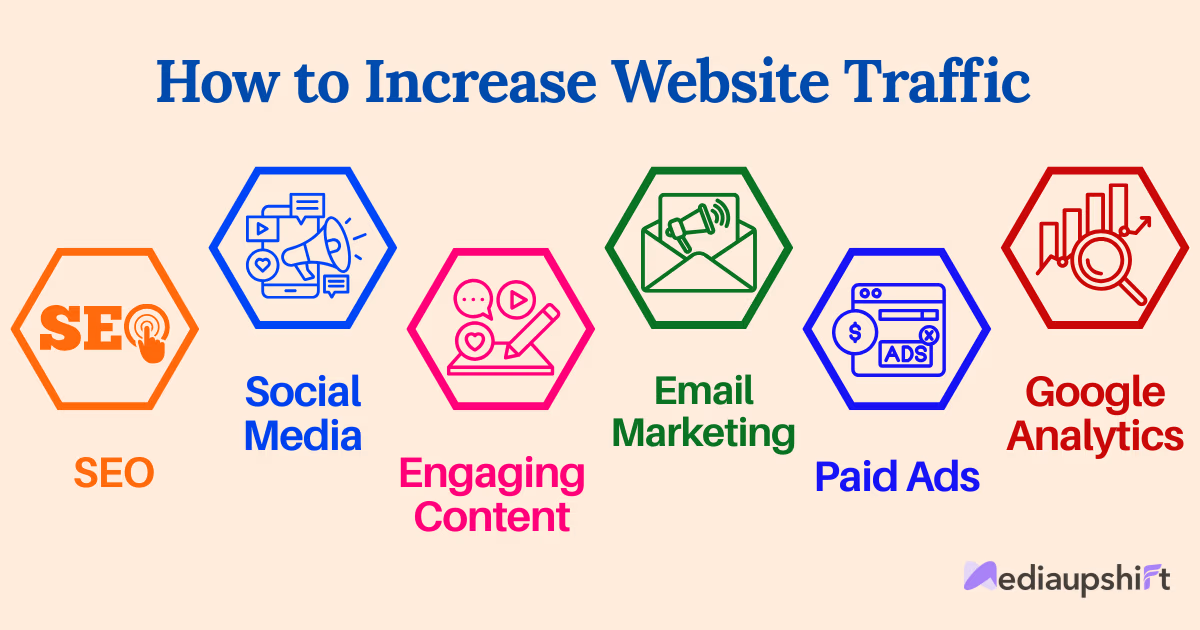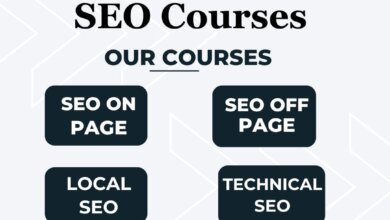
In today’s competitive digital landscape, driving quality traffic to your website is crucial for business success. Whether you’re running an e-commerce store, a blog, or a corporate website, implementing effective digital marketing strategies can significantly boost your online visibility and attract your target audience. Here’s a comprehensive guide to increase website traffic through proven digital marketing techniques.
Understanding Website Traffic Goals
Before diving into specific strategies, it’s essential to define what quality traffic means for your business. Quality traffic consists of visitors who are genuinely interested in your products, services, or content and are likely to convert into customers or engaged users. The goal isn’t just to increase numbers but to attract the right audience that aligns with your business objectives.
Search Engine Optimization (SEO): The Foundation
SEO remains one of the most effective ways to drive organic traffic to your website. This long-term strategy involves optimizing your website to rank higher in search engine results pages (SERPs).
On-Page SEO Techniques: Start with comprehensive keyword research to identify terms your target audience is searching for. Incorporate these keywords naturally into your content, meta titles, descriptions, and headers. Optimize your website’s loading speed, ensure mobile responsiveness, and create a clear site structure with proper internal linking. High-quality, valuable content that answers user queries is crucial for SEO success.
Technical SEO Elements: Focus on improving your website’s technical aspects, including XML sitemaps, robots.txt files, schema markup, and URL structure. Ensure your website is secure with HTTPS and fix any crawl errors or broken links that might hinder search engine indexing.
Off-Page SEO Strategies: Build high-quality backlinks from reputable websites in your industry. Guest posting, creating shareable content, and engaging in legitimate link-building practices can significantly improve your domain authority and search rankings.
Content Marketing: Creating Value for Your Audience
Content marketing is about creating and distributing valuable, relevant content to attract and retain a clearly defined audience. This strategy not only drives traffic but also establishes your brand as an authority in your field.
Blog Content Strategy: Regularly publish informative blog posts that address your audience’s pain points and interests. Create comprehensive guides, how-to articles, industry insights, and trending topic discussions. Consistency is key – maintain a regular publishing schedule to keep your audience engaged and search engines crawling your site frequently.
Diverse Content Formats: Expand beyond traditional blog posts to include infographics, videos, podcasts, case studies, and interactive content. Different formats appeal to different learning styles and can help you reach a broader audience across various platforms.
Social Media Marketing: Expanding Your Reach
Social media platforms offer excellent opportunities to drive traffic back to your website while building brand awareness and community engagement.
Platform-Specific Strategies: Choose platforms where your target audience is most active. For B2B businesses, LinkedIn might be most effective, while visual brands might thrive on Instagram or Pinterest. Share your content strategically, engage with your followers, and use platform-specific features like Stories, Reels, or LinkedIn articles to maximize visibility.
Community Building: Focus on building genuine relationships with your audience rather than just broadcasting your content. Respond to comments, participate in relevant discussions, and share valuable content from other sources to establish yourself as a helpful resource.
Pay-Per-Click (PPC) Advertising: Immediate Results
PPC advertising through platforms like Google Ads, Facebook Ads, or Microsoft Advertising can provide immediate traffic boosts while you work on long-term organic strategies.
Google Ads Strategy: Target high-intent keywords related to your products or services. Create compelling ad copy with clear calls-to-action and ensure your landing pages are optimized for conversions. Use ad extensions to provide additional information and improve your ad’s visibility.
Social Media Advertising: Leverage the detailed targeting options available on social media platforms to reach specific demographics, interests, and behaviors. Create visually appealing ads that resonate with your target audience and drive them to relevant landing pages on your website.
Email Marketing: Nurturing Existing Relationships
Email marketing remains one of the highest ROI digital marketing channels and can be an effective way to drive repeat traffic to your website.
List Building Strategies: Create compelling lead magnets like free guides, webinars, or exclusive content to encourage email signups. Use opt-in forms strategically placed on your website, including exit-intent popups and content upgrades.
Email Campaign Types: Send regular newsletters featuring your latest content, promotional emails for products or services, and automated email sequences for new subscribers. Always include clear calls-to-action that direct recipients back to specific pages on your website.
Influencer and Partnership Marketing
Collaborating with influencers and industry partners can expose your brand to new audiences and drive qualified traffic to your website.
Micro-Influencer Partnerships: Work with micro-influencers who have engaged audiences in your niche. These partnerships often provide better ROI than working with mega-influencers and can drive highly targeted traffic to your website.
Guest Posting and Collaborations: Write guest posts for reputable websites in your industry, participate in podcast interviews, and collaborate with other businesses on content projects. These activities can drive referral traffic and improve your brand’s visibility.
Analytics and Optimization: Measuring Success
Implement robust analytics tracking to understand which strategies are driving the most valuable traffic to your website.
Key Metrics to Track: Monitor organic traffic growth, conversion rates, bounce rates, average session duration, and traffic sources. Use tools like Google Analytics, Google Search Console, and social media analytics to gather insights about your audience’s behavior.
Continuous Improvement: Regularly analyze your traffic data to identify what’s working and what isn’t. Conduct A/B tests on your content, ads, and website elements to optimize for better performance. Stay updated with digital marketing trends and algorithm changes to adapt your strategies accordingly.
Building Long-Term Success
Increasing website traffic through digital marketing requires patience, consistency, and a willingness to adapt. Focus on creating genuine value for your audience, and the traffic will follow naturally. Remember that sustainable traffic growth comes from building trust and authority in your industry rather than relying solely on quick fixes or manipulative tactics.
The most successful websites combine multiple digital marketing strategies, creating a comprehensive approach that addresses different stages of the customer journey. Start with the strategies that align best with your resources and goals, then gradually expand your efforts as you see results and gain experience.
By implementing these digital marketing strategies consistently and measuring their effectiveness, you’ll be well on your way to achieving sustainable website traffic growth that contributes to your overall business success.







